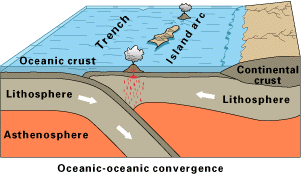1. How can ocean floor features be measured and mapped using current acoustical technology? How can ocean floor maps be used in the commercial, military, and/or private sector?
The first modern breakthrough in seafloor mapping came with the development of sonar, which was first used in the first world war. By the 1920s, the Coast and geodetic survey was using sonar to map deep water areas. The team of A.C. Veatch and P.A. Smith produced maps that showed that the canyons off the east coast of the united states extended into very deep water. During WWII, advances in sonar and electronics improved bottom mapping systems. This permitted oceanographers to construct the first detailed maps with important features such as the deep-sea trenches and mid-ocean ridges. These early maps provided the context for the plate tectonics theory in the 1960s. This theory gave a unified explanation for the formation of mid-ocean ridges, trenches, mountain ranges and other ocean bottom features.
2. define the following ocean floor features (your model maps contained at least three of them) and provide pictures for three of them.
 Guyot:
Guyot: A flat-topped submarine mountain, common in the pacific ocean, usually an extinct volcano whose summit did not reach above the sea surface.
 The mid-ocean ridge:
The mid-ocean ridge: an underwater mountain range, formed by plate tectonics.
 Island arc or trenches are major structural features, together with oceanic ridges, of ocean basins. As the name implies, island arcs are typically a curving chain of volcanic islands occurring around the margin of ocean basins. The curvature and the volcanic nature are important characteristic features. The arc is convex toward the ocean and concave toward the continent with a deep trench running parallel to the arc along the convex (ocean) side.
Island arc or trenches are major structural features, together with oceanic ridges, of ocean basins. As the name implies, island arcs are typically a curving chain of volcanic islands occurring around the margin of ocean basins. The curvature and the volcanic nature are important characteristic features. The arc is convex toward the ocean and concave toward the continent with a deep trench running parallel to the arc along the convex (ocean) side.
Arcs and trenches are hundreds of miles long. Some well-known examples of island arcs are Japan, Aleutian Islands of Alaska, Mariana Islands, all of which are in the Pacific, and the Lesser Antilles in the Caribbean. The abundance of volcanic rocks around the Pacific Ocean has led to the designation of the Pacific margin as a “Ring of Fire”. Most of the world’s active volcanoes are in this belt.



